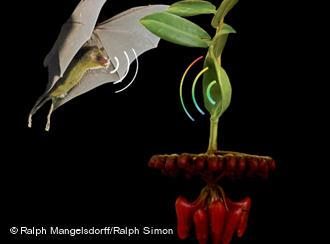Think of a plant trying to attract a pollinator and the image of brightly coloured flowers with sweet bowls of nectar perhaps come to mind. You might also be aware of the ultraviolet landing strips that guide insects towards the flowers sexy bits where pollen is picked up and deposited. There are even plants the flowers of which resemble female insects and so a libidinous male will attempt to mate unwittingly with the structure and do the pollen transfer business too.
What I didn’t know until I read “The Sound Book” by Trevor Cox is that some plants use, not brightly coloured flowers, but noisy leaves to attract their specific pollinator. The Cuban vine, Marcgravia evenia, stands out aurally from the rainforest crowd. At least to the local bats. The vine produces a ring of flowers on an arching stock and atop the stalk a leaf that is concave and hemispherical hangs over the flowers. This structure reflects the ultrasonic chirps from the bats hunting insects on the wing.

Amazingly, while the vegetation of the rainforest presents to the bat a complicated soundscape of endless echoes that shimmer and shake as it flies through the trees, that convex vine leaf is a steady signal. No matter at what angle the bat flies past, it can sense the vine as the chirps are focused by the leaf. Marc Holderied of Bristol University, UK, and colleagues have confirmed (in 2011, it was all over the science news, how did I miss it?) that the bats benefit from the presence of these leaves in the rainforest, finding food twice as fast in areas where the vine grows than when there are none. For its part, the plant increases its chances of being pollinated by being a focus of the chiropterine aviators who also benefit from a tasty supply of nectar from the ring of flowers.
How could you not want to read a book that reveals such a wonder? Cox, who acoustically engineers classrooms and concert halls for a living reveals many more exotic noises: creaking glaciers, whispering galleries, stalactite organs, musical roads, humming dunes, seals that sound like alien angels, and a Mayan pyramid that chirps like a bird. Listen up, this is a book worth reading.
The Sound Book: The Science of the Sonic Wonders of the World Paperback (2015) Trevor Cox, Published by W. W. Norton & Co; ISBN-10: 0393350584 ISBN-13: 978-0393350586.